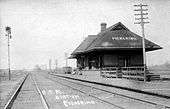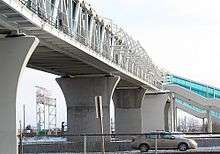Pickering GO Station
Pickering | |||||||||||
|---|---|---|---|---|---|---|---|---|---|---|---|
 | |||||||||||
| Location |
1322 Bayly Street Pickering, Ontario | ||||||||||
| Coordinates | 43°49′50″N 79°05′06″W / 43.83056°N 79.08500°WCoordinates: 43°49′50″N 79°05′06″W / 43.83056°N 79.08500°W | ||||||||||
| Owned by | Metrolinx | ||||||||||
| Platforms |
3 side platforms (train) loop with bays (bus) | ||||||||||
| Tracks | 3 | ||||||||||
| Connections | |||||||||||
| Construction | |||||||||||
| Structure type | Station building and tunnels and elevators to platforms | ||||||||||
| Parking | 2,508 spaces | ||||||||||
| Bicycle facilities | Yes | ||||||||||
| Disabled access | Yes | ||||||||||
| Other information | |||||||||||
| Station code | GO Transit: PKGO | ||||||||||
| Fare zone | 91 | ||||||||||
| History | |||||||||||
| Opened | 23 May 1967 | ||||||||||
| Services | |||||||||||
| |||||||||||
Pickering GO Station is a train and bus station in the GO Transit network[1] located in Pickering, Ontario, Canada. It is a stop on the Lakeshore East line and was the eastern terminus from 1967 until 1990, when service was extended to Whitby and subsequently to Oshawa.
History

The previous Pickering station, which had been constructed by Grand Trunk Railway in the early 1900s, had been about 2 kilometres east of the current location at Liverpool Road. Plans for the original GO Transit Lakeshore line called for commuter train service not to go beyond Liverpool Road where the CN York Subdivision tracks joined the CN Kingston Subdivision, because this would interfere with freight trains. No practical site could be found, but there was a large field south of the tracks on the east side of Liverpool Road with more than enough space to accommodate a station building, bus terminal and car parking, with convenient access from Bayly Street. Installation of a new crossover before the overpass at Liverpool Road was required to get to an existing industrial track, so that GO Trains standing at the station platform would be off the main line.[2]
When the station opened in 1967 it was a key transfer point between train and bus services.
In 1990 the single platform was supplement by two more platforms and tracks when GO Transit built a dedicated right-of-way on the north side of the Canadian National tracks. This was part of the project to expand Lakeshore East train service to Ajax and Whitby, and finally to a new terminus at the Oshawa Via Rail station in 1995.
Station layout
Pickering has three platforms for trains, 1 and 2 which serve trains to Union and trains to Oshawa. Track 3, separated from the other tracks, is closest to the bus bays and station. Track 3 is the original track before the extension to Oshawa, which serves Express and Local trains to and from Union which terminate in Pickering.
A pedestrian walkway (to eliminate need for passengers to cross CN tracks to travel from the station to the bus terminal) was completed in 2012, and a new multi-level parking structure is being built at the station and will be completed by spring/summer 2014 with an expected capacity of 1500 new parking spaces.[3] Exterior cladding of the bridge in a metallic mesh has proved to be problematic and, along with severe weather, has been giving the contractors trouble. It is now expected that the bridge will not be completed until the summer of 2015.[4]

Connecting bus routes
The station is the Pickering hub for Durham Region Transit local bus services, which evolved from the Bay Ridges Dial-a-Bus in 1970.
- Durham Region Transit service
- [5]
- 101 / 101A Industrial / Bay Ridges
- 103 / 103B Glenanna / Strouds
- 107 South Rosebank
- 110 / 110A / 110B Finch West
- 111 / 111A East Pickering
- 112 Brock
- 120 - Whites
- 181 / 182 Pickering Late Night Shuttle
- GO Transit
- 98 - Pickering/Finch Express
- 51B - U of T Scarborough/Richmond Hill/York U, Pickering/York U Express
- 90B/C - Oshawa GO, Oshawa/Courtice/Bowmanville/Newcastle
References
- ↑ "Pickering GO Station— TRAIN & BUS STATION". GO Transit. Retrieved March 2014. Check date values in:
|access-date=(help) - ↑ Wilfred Sergeant (2004). "Building GO-Transit". 8: Locating the stations. HTA PRESS. Retrieved March 2014. Check date values in:
|access-date=(help) - ↑ http://www.680news.com/news/local/article/349523--sections-of-pickering-go-station-closed-for-construction
- ↑ Carola Vyhnak (7 February 2014). "Pickering's GO pedestrian bridge inching along". Torstar News Services. Retrieved February 2014. Check date values in:
|access-date=(help) - ↑ "NEW Route Maps". Durham Region Transit Website. Retrieved 10 July 2016.
External links
 Media related to Pickering GO Station at Wikimedia Commons
Media related to Pickering GO Station at Wikimedia Commons